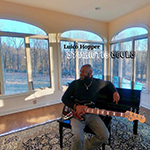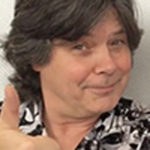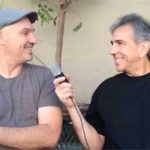Funky Broadway and session bassist tells us about Motown: The Musical and his new album
Exclusive interview with FBPO’s Jon Liebman
January 25, 2021
They say the neon lights are bright on Broadway. Luico Hopper can tell you about them firsthand. The Virginia native has played bass in a string of Broadway hits, including Five Guys Named Moe, Bring In Da Noise, Bring In the Funk and Motown: The Musical. He’s also a successful studio and touring musician who’s worked with artists like Roberta Flack, Gil Evans, Diana Ross, Earl Klugh, Johnny Gill, Gato Barbieri, Luther Vandross, and Bryan Ferry. Beyond that, he’s recorded scores for numerous radio and television commercials. Hopper released his third solo effort, Symbiotic Souls, this past September.
FBPO: You were surrounded by music pretty much from the beginning. Tell me about your musical upbringing and how you were first exposed to music.
LH: I grew up in the South, on a farm, and my father played guitar and a few other instruments, piano and stuff. He had a guitar when I was really small, and he used to play. I took a real liking to that, and my mother sang. We were churchgoers at the time, and I sang just through school and everything. I got into music in elementary school actually, just singing, not playing any instruments. And then when I went to high school, I played clarinet, alto clarinet and bass clarinet.
FBPO: So clarinet was your first instrument?
LH: Yeah. That was really my first instrument.
FBPO: You and Marcus Miller.
LH: Yeah, that’s right! That’s true. I played that, and then my father, something happened with his guitar, so he didn’t have it around that time. But my brothers who lived in New York sent us a classical guitar. My younger brother and I learned to play together. He is about three years younger. And then I got my own electric guitar and I just kept playing. I always sang bass lines, so when I went to college, with my financial aid money, I went and bought up a MusicMaster bass, and pretty much taught myself how to play it in the dorms.
FBPO: I don’t think that’s what the government had in mind with your financial aid money.
LH: No, they did not! [Laughs]
FBPO: Once you discovered the bass, who were your influences?
LH: Well, I remember picking up … probably one of the first songs I learned was “For the Love of Money” you know, Anthony Jackson.
FBPO: He was really young when he played that.
LH: He was young. We’re basically the same age, but I wasn’t even touching the bass, and he was playing that. All the guys up north were doing it when they were really young. I did nothing, but I fell in love with it. I was majoring in sociology, which I stayed with the whole time I was in college. But I always loved the bass, always sang bass lines. I started playing some gigs while I was in college, just folk gigs. And when I got out, I was working at a drug program, counseling young kids, teenagers, and I had my bass there all the time. My sister happened to be a nurse at the program, and Dannie Richmond came through. He used to see me playing my bass. We talked and he said, “When I was young, I went up to New York.” I think he went to Juilliard for a little while, and he just told me how he made it. I had family in New York, so I said, “You know what, I’m going do that one day.” And I did, about two years later, I just came to New York and just tried to make it with music.
FBPO: Obviously, you did more than try. How did you manage to break into the New York music scene? That’s no easy feat.
LH: You know what, man, being naive is a good thing sometimes. And also, if you’re just not afraid. That’s what I tell young musicians. I would go up to people on the train. I called Lenny White when I first got to New York, because … actually, I was playing in a band in North Carolina with a bunch of guys from Berklee that were in a group that was produced by Joe Zawinul. So I ended up auditioning and getting that gig while it was still down south, before I moved to New York. When I came to New York, I had a few contacts, and Lenny White was one. I have to credit him with helping me the most because I went out to his house, I said, “Man, I want to play with you.” And he said, “Yeah, come on out.” So I went out to his house.
FBPO: Approximately what year was that?
LH: We’re talking 1976. I went out there, and he picked me up from the train station in his Porsche. We went to his house, and we hung out for about an hour, and then we went down in the basement, and he said, “Okay, let’s play something.” He had his drums, he had the amps and everything, keyboards. And I took my bass out and I was so excited, and he put all of these Return to Forever charts in front of me, and I couldn’t read a note. I could read treble clef, but I couldn’t really read the bass clef that well because I taught myself electric bass pretty much. But I could play a little bit of classical bass, which I did in college.
FBPO: You played upright in college?
LH: I picked up the upright probably like my freshmen [year]. As soon as I started playing electric bass, I got in the school orchestra, the jazz band. I couldn’t play upright at the time, but I had a really great classical guy there and he just taught me personal lessons on upright.
FBPO: You must have gotten pretty good at reading at some point, especially with all those Broadway shows you played.
LH: Boy, for almost six or seven to nine months, I did nothing but practice all day long, reading music. A bass player I met on the train turned me on to Carol Kaye books. Just took it from there, I taught myself to read.
FBPO: Of all the Broadway shows you played, I bet Motown: The Musical must have been really special, playing all those James Jamerson lines.
LH: It was! It was special because I didn’t learn to play the bass playing his lines. When I started, I was just into Jimi Hendrix, and Billy Cox and Noel Redding. I was into the rock stuff. That was the ’70s, so I wasn’t into Motown too much. But I had all that stuff in my head. That’s probably the bass lines I was singing, when I started. But I never played Jamerson, so I got a chance to really dig into Jamerson and that was incredible. I’m still digging into it.
FBPO: Did you ever go through the Standing in the Shadows of Motown book?
LH: That’s what I did. I was doing a show, Priscilla, Queen of the Desert, at the time, when I got the call to do Motown. I had to do showcases, and so I just went over to 48th Street and bought the book Standing in the Shadows and that’s how I prepared for the show. I’m from the South, I didn’t get to hear jazz. I didn’t know what jazz was until I basically went to college. All I heard was Country & Western and rock and roll. That’s what I grew up wanting to play at the time.
FBPO: Let’s talk about your new record, Symbiotic Souls. It’s smooth, it’s funky, it’s got R&B, it’s got some upright… How did you manage to balance all those elements into one cohesive project?
LH: It wasn’t hard at all. I wanted to play my upright bass, because I play it on shows and stuff. I was doing Noise/Funk one time and I forgot my upright, I forgot my electric bass. I caught the train from Marstown to the city, and when I got there, I realized, oh shit, I don’t have my bass, because a lot of times, I would just leave it in the locker. So I had to play the whole show, which was a lot of funk, on upright. I thought it was pretty hip, everybody dug it. And I said, “You know what? I’m going to start using upright in my own stuff, in funk stuff.” I just experimented. I have my own studio, so I can experiment with what I want. I just try to play my different basses that I love.
FBPO: You’re lucky that particular situation worked out. Is there a lot of slapping in that show?
LH: Oh, in Noise/Funk it was. I played a lot with my thumb.
FBPO: I’ve seen Stanley [Clarke] do that on the upright.
LH: Oh, yeah. Stanley and Alex Blake, they’re like kings of that slap stuff on an upright. I don’t do that too much.
FBPO: Tell me about your gear.
LH: For my five-string, I play a Sadowsky bass, mostly. I have one of his first basses. I got it in ’94 or ’95, or something like that. My favorite bass is an early ’70s jazz bass, which has been around the world a few times. Then I have a ’66 Precision, a newer fretless Fender. We relocated to Las Vegas in February, so actually, I got rid of some basses that I wish I wouldn’t have now. I have a 6-string bass, which I used a lot on my record. It’s a Fender 6, made in Japan, though. It was made in ’85, it’s one of their prototypes.
FBPO: The Fender sixes never really seemed to take off.
LH: No, they didn’t. But I know they used to double uprights with it, so I did that on my record. I just experimented. It’s because sometimes an upright, getting the fidelity and everything to come out, like in melodies and stuff, so I would double it with that. And I actually play it a lot. I’ve been practicing a lot since the pandemic has been around. And then I have two uprights, old Juzek, probably pre-World War II or something like that. And then I have a 1961 American Standard bass that I absolutely love. I got that in 2016. That’s basically my basses.
FBPO: What kind of strings do you play?
LH: I endorse La Bellas, so on my fretless and my Precision I use La Bellas. I use the Tapewound, the black strings sometimes on my fretless, and I use the regular La Bellas, not the ones Jamerson used, but I use the ones that are a little bit wider, the Deep Talkin’ 760FS.
FBPO: What do you like about La Bella strings?
LH: Well, when I started doing Motown, I just got the endorsement. They contacted me and sent me all kinds of strings and they just seem to work. And I’ve been using them ever since. I never have to change them. I have a bunch here, but the same ones have been on my bass since 2012 or something like that.
FBPO: What kind of amps do you play?
LH: I have a ’67 Ampeg B-12.
FBPO: Classic.
LH: That I have here in my studio, and I have a MESA/Boogie amp, the Subway, 800. I haven’t used it on a gig yet, but I got it when I first moved here in February. I like just playing through it here at home. And then I use an Acoustic Image for my upright bass.
FBPO: What’s keeping you busy these days?
LH: I’m just starting to dive into doing some videos. I’m doing that a lot. I’ve been able to stay busy. I’m doing tracks from my house, too. I have a couple of projects that are lined up that I need to put some bass on for some people. I have all these instruments. I practice guitar a lot, and I practice my upright. I’m just working on stuff that I didn’t get a chance to do when I was very busy in New York. Eventually, I’m hoping I can get back to playing. There’s a lot of playing out here. I would like to play with my own band, which is something I’ve always done on and off.
FBPO: What took you to Vegas from New York?
LH: I play with Smokey Robinson sometimes, so I played here a bunch of times over the years. I was here last year with him for a week and I just hung out a little bit and I kind of liked the vibe. And I’ve always had a bad vibe about Vegas, thinking that it was just for gambling and that kind of stuff. But we moved to a place called Summerlin, and it’s about 20 miles from the Strip, and it’s just really nice. The weather’s nice here, we’re right near the mountains, Red Rock Canyon. My wife came here, we were moving to California, because I have a daughter in San Francisco. And when we got there, we just didn’t vibe it. So we came and she said, “Well, let’s just give it a try” because I kept saying, we should go check out Vegas. And when we came to Summerlin, we really liked it, and we wanted warm weather. After shoveling snow for so many years, it’s a nice change.
FBPO: What would you be if you weren’t a bass player?
LH: I’d probably be into electronics or something like that. Also, I was a counselor for a little while. I don’t know if I would be in that field. My father used to say, “Oh, you can’t make it playing music.” He used to tell me that when I was about 17. He said, “You better go to college and get a degree in something.” And I came right out and just started doing music, so I said, “Man, I could have just done music from the start.” I ended up doing sociology, but it’s all worked out.
See Jon’s blog, with key takeaways from this interview here.
Luico’s latest release, Symbiotic Souls, is available here.
Standing in the Shadows of Motown is available in the FBPO store.
Standing in the Shadows of Motown









